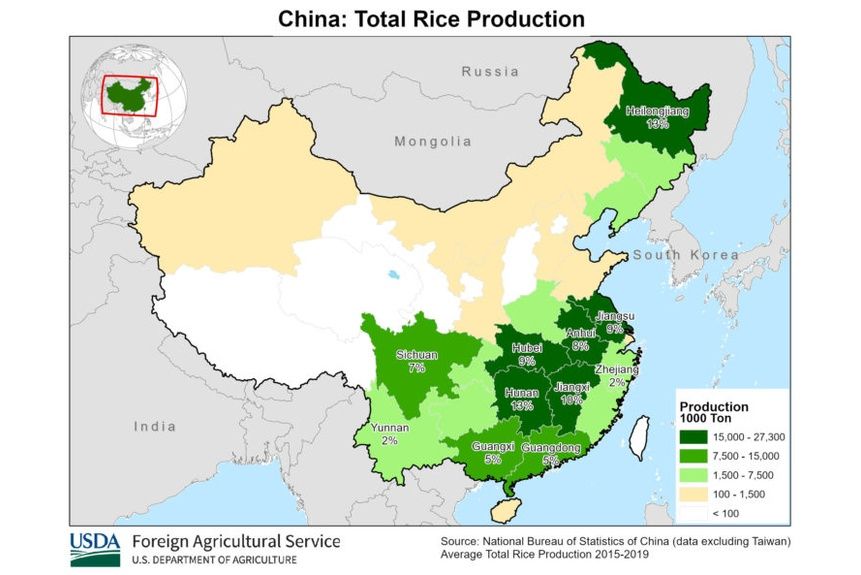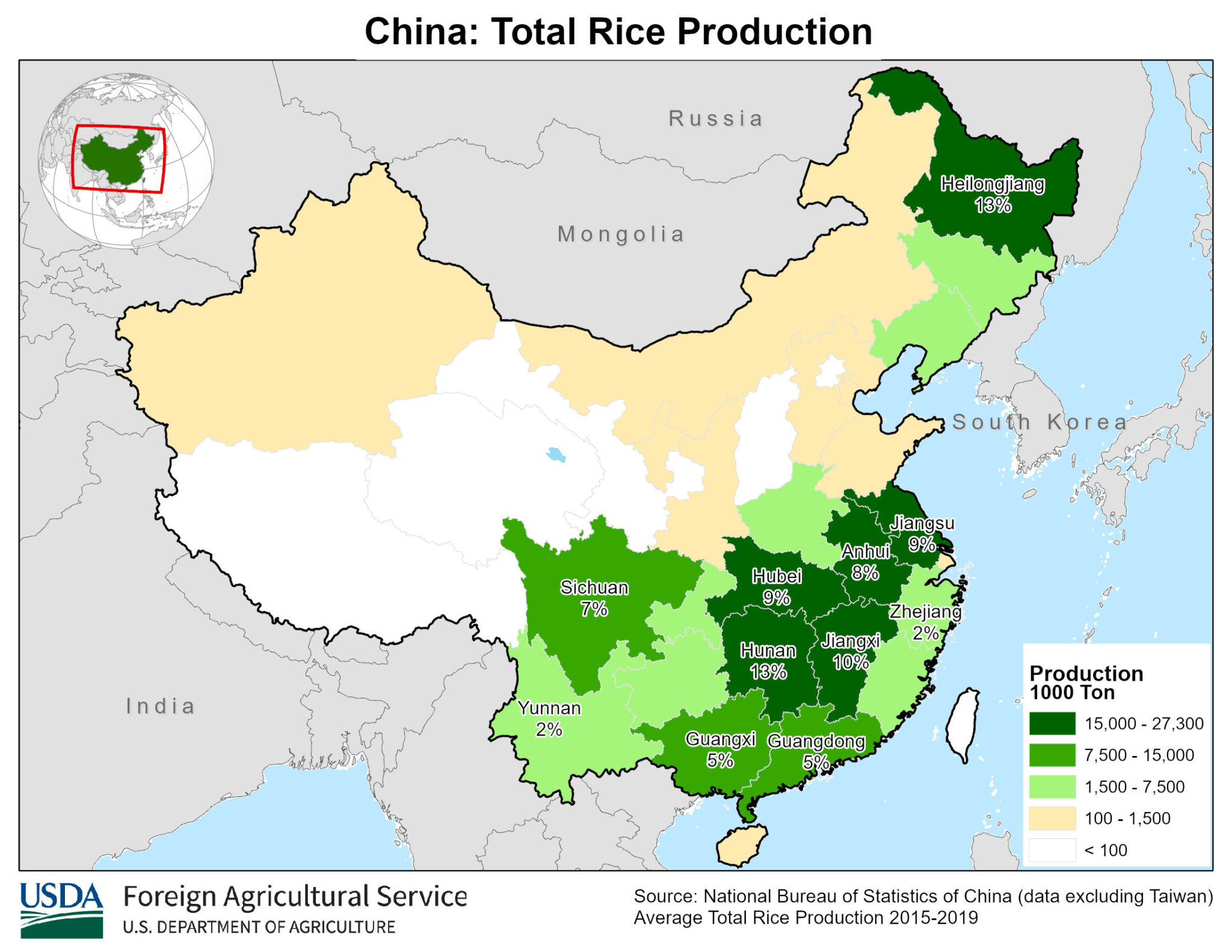
China Addresses Food Security at Home, Uses “Food Diplomacy” Abroad
By Peter Wood
The combination of COVID-19 and the outbreak of war in Ukraine have demonstrated the vulnerability of the global food supply through prevalence of price shocks leading to increasing hunger. For its part, China is taking threats caused by food insecurity seriously. China’s leader, Xi Jinping, included food security in his 2014 articulation of a “Holistic National Security Concept.”

China: Total Rice Production (2015-2019).
“China is actively committed to promoting international food security cooperation.”
The combination of COVID-19 and the outbreak of war in Ukraine have demonstrated the vulnerability of the global food supply through prevalence of price shocks leading to increasing hunger. For its part, China is taking threats caused by food insecurity seriously. China’s leader, Xi Jinping, included food security in his 2014 articulation of a “Holistic National Security Concept.”[i] As illustrated in the following excerpts, food security remains a driving force for Chinese policy, including efforts to improve its self-reliance and insulate itself from global food market shocks, while at the same time advancing relations with strategically important trade partners and diversifying its trade partners to reduce impacts from market fluctuations.
In March 2021, China issued its latest five-year plan, which will guide policy through 2025. The excerpted portion of the plan below lays out some of the core elements of China’s domestic initiatives to improve food security. These include efforts to better use mechanization and bring small agricultural plots together for greater efficiency. The plan also called for increasing soil restoration projects to return arable land that had been polluted. In January 2022, the State Council commissioned a national soil survey to systematically study the level of pollution, which previous surveys had found to be significant.[ii] In his speech at the 20th Party Congress in October 2022, Xi reinforced many of these themes, calling for greater efforts to ensure that China’s target of arable land is protected, existing land is used more efficiently, and better seed technologies are incorporated.
Xi also sees food security as central to his foreign policy. Xi’s Global Development Initiative,[iii] introduced in an address to the UN General Assembly in September 2021 as a complement to China’s Belt and Road, makes food security and “food diplomacy” an important plank.[iv] The excerpted article by Zhang Lubiao, Director of China’sMinistry of Agriculture and Rural Affairs’ Foreign Economic Cooperation Center in People’s Daily, the official mouthpiece of the Chinese Communist Party’s Central Committee, lays out some examples of China’s food diplomacy. Zhang cites China’s historical commitment to the export of these technologies and the training of thousands of technical personnel since 1979. Notably, the article highlighted how China had helped several countries, including Nigeria, the most populous country in Africa, improve yields and the variety of key staples, leading Nigeria to become a major rice-producing country itself. Going forward, food security—and China’s sprint to reduce its exposure to global markets—are likely to remain a major theme of both its foreign and domestic policies.
Sources:
“中华人民共和国国民经济和社会发展第十四个五年规划和2035年远景目标纲要 (Outline of the People’s Republic of China 14th Five-Year Plan for National Economic and Social Development and Long-Range Objectives for 2035),” Xinhua (PRC State Media), 13 March 2021. http://www.gov.cn/xinwen/2021-03/13/content_5592681.htm
We will consolidate the foundation of grain production capacity and ensure the supply of important agricultural products…We will enforce the strictest possible system for protecting farmland, strengthen the protection of the quantity of available farmland and enhance its quality to ensure that the total area of China’s farmland remains above the red line of 120 million hectares [十八亿亩耕地红线] (~296.5 million acres[i]), prevent the use of farmland for non-agricultural and non-grain purposes… Focusing on functional zones for grain production and protected areas for the production of major agricultural products, we will build a ‘national food security industrial belt’, implement high-quality farmland development projects, and build contiguous high-quality farmland of more than 71.67 million hectares.
It is essential to improve the systems to guarantee the supply of major agricultural products and to the production, purchase, storage, marketing, and sale of grain, to ensure absolute security of staples, basic self-sufficiency of grain, and adequate supply of major agricultural products and byproducts products. Efforts will continue to develop grain production, further implement the strategy of sustainable farmland use and innovative application of agricultural technology for national food security, carry out research to overcome the technological bottleneck of superior seed sources, and improve self-reliance and control[ii] of seed types.
Zhang Lubiao, “中国杂交水稻技术助力维护全球粮食安全 (Hybrid Rice Technology is a Hallmark of China’s International Agricultural Cooperation),” People’s Daily (Official Newspaper of the Chinese Communist Party’s Central Committee), 13 November 2022. http://paper.people.com.cn/rmrb/html/2022-11/13/nw.D110000renmrb_20221113_7-03.htm
While simultaneously addressing the problem of domestic self-sufficiency, China is actively committed to promoting international food security cooperation and working with all parties to enhance global sustainable agricultural production capacity…. China has also trained more than 14,000 hybrid rice professionals from more than 80 developing countries through international training courses.
In order to promote hybrid rice technology, China has sent a large number of agricultural technical experts. According to incomplete statistics, by the end of 2021, under the framework of China-FAO South-South Cooperation alone, China has sent nearly 1,100 agricultural experts and technicians to more than 40 countries and regions, accounting for nearly 60% of the total number of dispatched experts.
…
Cooperative hybrid rice projects involving China, Nigeria, Uganda and other countries have also achieved remarkable results. China has helped Nigeria make great progress in the field of rice planting by sending experts, promoting improved crop varieties, and providing technical support, and has become one of the major rice-producing countries in Africa.
Sources Notes:
[i] The original phrase is 1.8 billion “mu,” a Chinese unit of measure. For comparison, in 2021 the U.S. had 895 million acres of farmland. While China is slightly larger than the U.S. in size, much of its land is mountainous, plateaus, or desert areas unsuitable for farming. See: “Farms and Land in Farms 2021 Summary,” USDA, National Agricultural Statistics Service, February 2022. https://www.nass.usda.gov/Publications/Todays_Reports/reports/fnlo0222.pdf
[ii] Here, control is referring to rights including patents. China still relies heavily on seed types that are patented by foreign countries.
Notes:
[i] “Holistic National Security Concept” [总体国家安全观].
[ii] “The State Council Notice on the Third National Soil Survey” [国务院关于开展 第三次全国土壤普查的通知], PRC State Council (Chinese Government), 29 January 2022.
http://www.gov.cn/zhengce/content/2022-02/16/content_5673906.htm
[iii] Global Development Initiative (GDI) [全球发展倡议].
[iv] Food security was mentioned second after poverty alleviation in a list of specific measures in a section discussing development. See: Xi Jinping, “Speech by Xi Jinping at the General Debate of the 76th Session of the United Nations General Assembly (full text),” [ 习近平在第七十六届联合国大会一般性辩论上的讲话(全文)], Xinhua, 22 September 2021. http://www.gov.cn/xinwen/2021-09/22/content_5638597.htm
Image Information:
Image: China: Total Rice Production (2015-2019).
Source: US Department of Agriculture, Foreign Agricultural Service, https://ipad.fas.usda.gov/rssiws/al/crop_production_maps/China/China_Total_Rice.jpg
Attribution: USG/Public Domain
Distribution A: Approved for public release
Categories:
Tags:







